A Tripple Slay for Hamburg: 3 Shows at Deichtorhallen
Hamburg delivered: Let's look at the life span of movie equipment, monumental close-ups, and tender portraits of dear friends.
FRANZ GERTSCH: BLOW-UP. A RETROSPECTIVE
I am very much a hyperrealism girlie. And as a fan of Franz Gertsch’s (1930–2022, Swiss) painting Maria does Luciano’s Make Up (1975) at Museum Ludwig, I was hyped to see his solo show in Hamburg.
The show follows the whole timeline of his career. Franz started with romantic paintings. From the 60s onwards, they turned into portraits made up of flat color shapes that look like a foreshadowing of Millennial Corporate Memphis illustrations. Franz’s first attempts at hyperrealistic painting look quite…shaky. In the portrait of Brecht, Hanne-Lore, Silvia (1970), he just fuckin chopped off that middle kid’s nose sitting in the bathtub. The group portrait Junkere 37 (1970) looks just as smudgy and sloppy as the first AI image attempts of 2022. And within just one year, in 1971, he finally entered his Slay Era. This is where Franz gets to his monumental portraits of friends, mostly set in interiors.
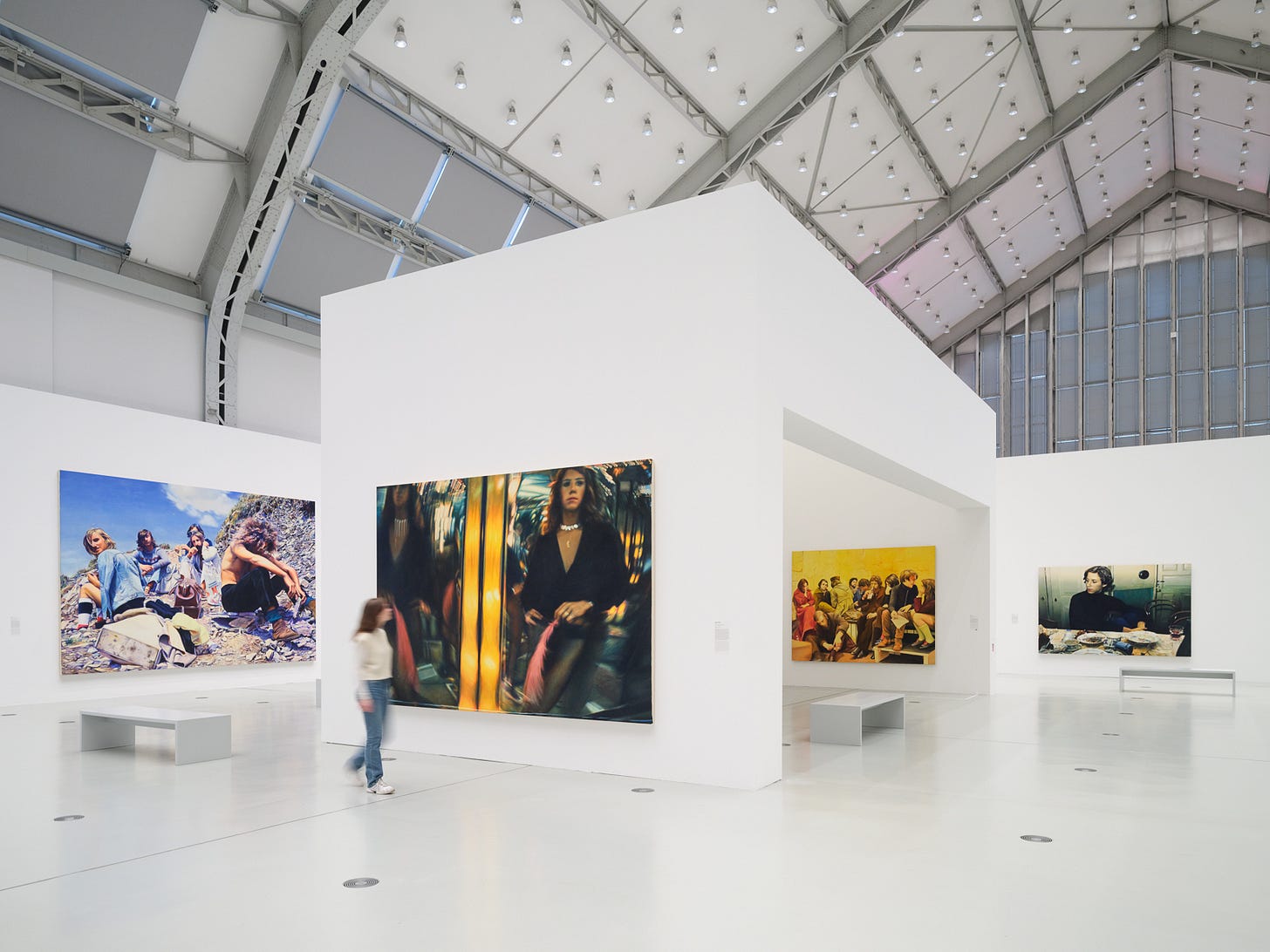
The biggest misconception about hyperrealism is what it’s copying. Hyperrealism isn’t about imitating what something looks like through your eyes. It’s about what something looks like through a photograph. To get the most accurate scale possible, Franz used photographs and projected images onto the surface. What clues does Franz leave that help us recognize his photographic source material? The monumental formats prove to be useful for observing the details.
Franz’s portrait Luciano I (1976) is revelatory. Pay attention to the color: The white doors behind Luciano get a green gradient downwards. Notice the greens, blues, and reds on his face, the blue tint in where his hair reflects the light, the color in the shadows, the blur in the lower left corner. All those details only make sense if you consider the photographic source.
The painting Saintes-Maries-De-La-Mer III (1972) depicts four kids at the beach. The girl to the very right must have just run into the shot: Her left foot in the lower right corner is hazy as if captured by the camera in the movement. Saintes-Maries-De-La-Mer I (1971) is dominated by a blue tint that might be attributed to the camera film used. In the context of a sunny beach day, it makes me think of how, when you face the sun with your eyes closed for a while, everything looks blue once you open them again.
The most obvious example is Spiegelkabinett (1974). A blurred person standing in a mirror labyrinth, their even more blurred reflection captured on the left. Movement and distortion dominate instead of photographic stillness. It seems as if Franz captured two reflections instead of the real person. The golden mirror frames divide the painting into a diptych.
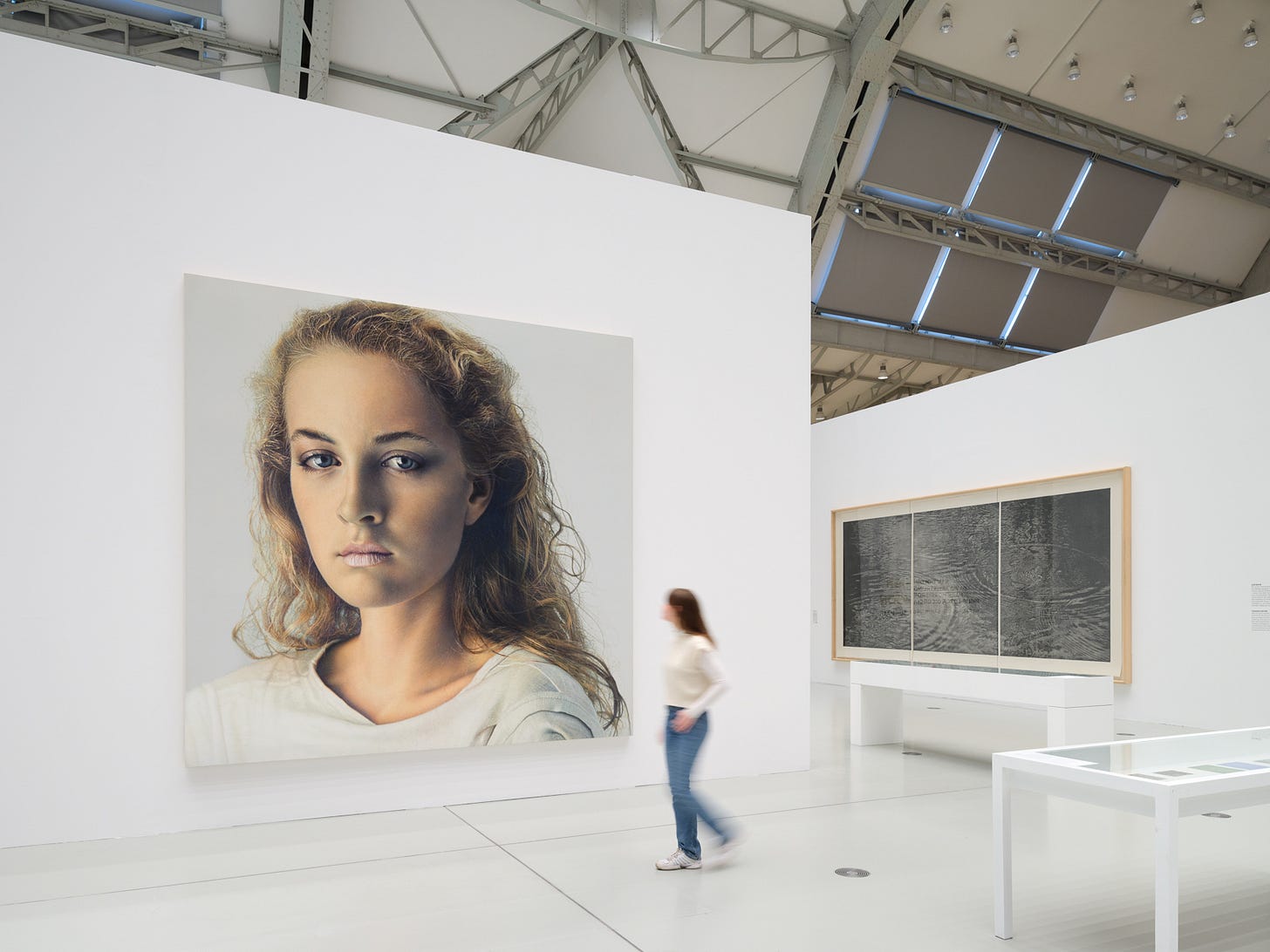
Speaking of diptychs and art history, two portraits opened intriguing references for me. Johanna I (1983-84) is extremely contemporary with her unmistakable 80s hairstyle and the metallic lip gloss. Next to her, Silvia I (1998) seemed the opposite: Painted with egg tempera, this fully frontal portrait embraces Italian Renaissance aesthetics. The coloration of the sky is specific to 15th-century portraiture. I thought of Piero del Pollaiuolo’s Portrait of a Woman (ca. 1480) or, more generally, of Piero della Francesca. The wall label refers to Albrecht Dürer and Leonardo Da Vinci. I’m not really convinced of a Leo reference here, only if it’s the deep, dark eyes. Al makes sense, given that he (re)introduced full frontal portraits for nonreligious contexts. But I still wouldn’t consider them explicit references because they idealized whom they portrayed. They aspired to perfection and visual order.
Silvia’s face doesn’t look facetuned to me. Her features aren’t perfectly symmetrical; the shadow falling onto her left half is unflattering even. A big part of Renaissance ideals was about imposing perfection on humans, even when the result had nothing in common with what humans are like. Sure, anatomic accuracy was a must in art, but the guy would be ripped anyway. Women would be blonde, pale, and have a big forehead, not because that’s what they all looked like, but because that’s the beauty standard in Petrarch’s poetry. A naturally uneven landscape in the background would be made symmetrical, composition over candidness. Franz is similarly interested in frozen perfection, creating an impeccably executed image. But the people in these pictures get to be who they are.
I didn’t know that Franz also worked with woodcuts; that’s an aspect the exhibition highlights. Those mainly depict nature, I almost mistook them for textiles or tapestries because of their intricacy — a word I wouldn’t usually apply to the rather rough woodcut technique. There was a video from 2018 of him in the studio painting one of those giant plants I saw in the show. His hands were shaking all along, and yet he managed to keep the precision he’s so well known for.
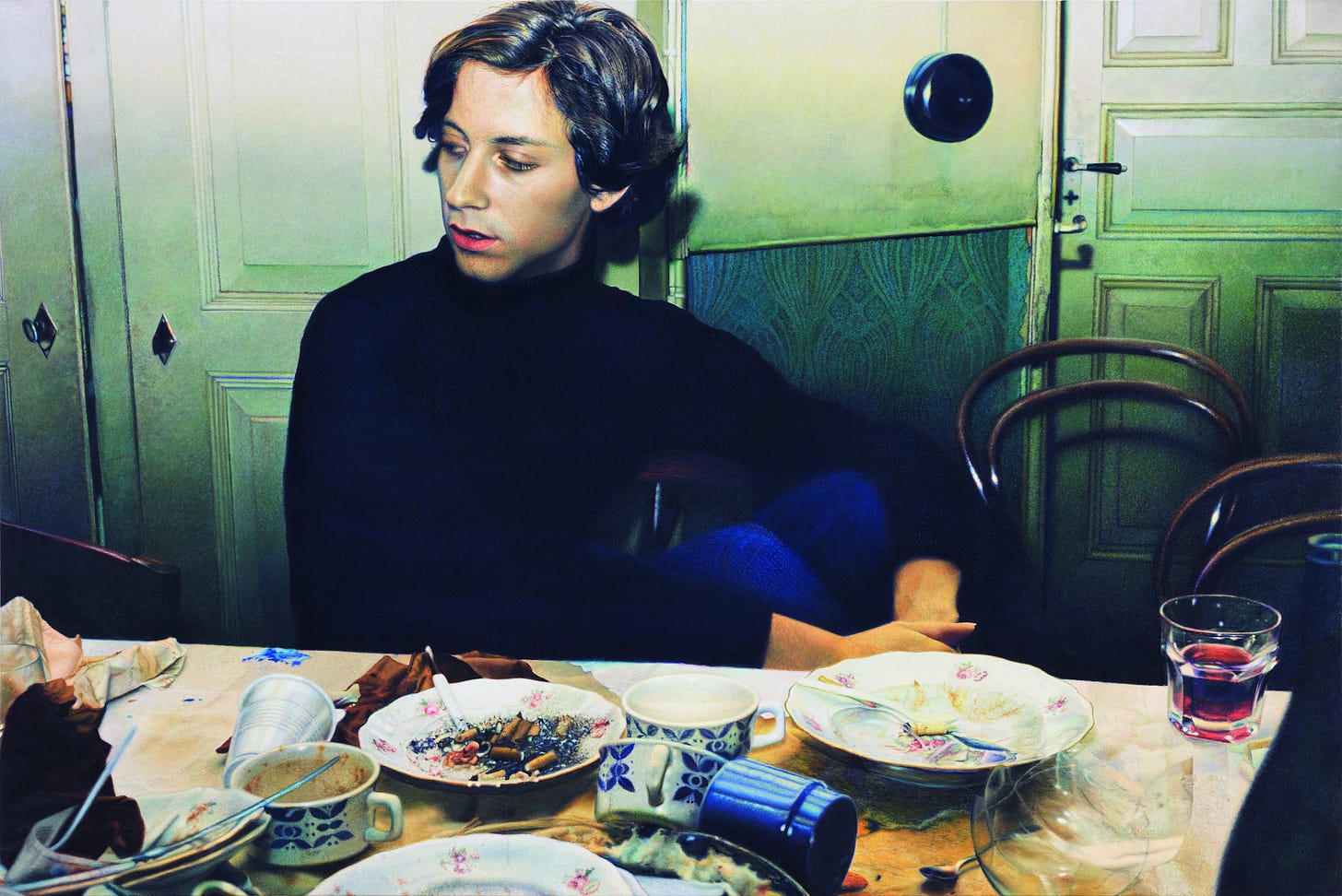
HIGH NOON
The group show features works by the US-American photographers Nan Goldin (Baby Boomer), David Armstrong (1954-2014), Mark Morrisroe (1959-89), and Philip-Lorca DiCorcia (Baby Boomer). The following unites them, if I may borrow from the press text: “Facing the political climate of the Reagan era of the 1980s, characterised by conservative values and neoliberalism, these photographers begin to capture New York's subculture in intense and often shockingly intimate images.”
Everybody knew each other in the scene back in the day. The same people reappear in photographs shot by different people, so it’s never one single perspective that dominates. And there are so many that didn’t make it to old age. Nan portrayed her best friend, Alf Bold, until he was taken away by AIDS. There’s one pic from 1993 of him lying in a hospital bed with yellow roses (flowers that are really only appropriate for hospitals), his eyes are closed. Researching, I found Nan saying this:
On August 18, 1993 I spent the day by the bedside of my best friend Alf Bold listening to his death-rattle. I left the hospital briefly to meet my friend Hans Werner's newborn son, Fritz. When I returned to the hospital an hour later Alf had died." — Nan Goldin, quote via Schellmann Art
I wonder what that must be like. See your friends not live past their prime. Holding their hand, knowing that you can’t do much except for anything you can to keep their memory alive. And then, how do you keep on living? How do you push through when your representatives tell you those deaths don’t matter?
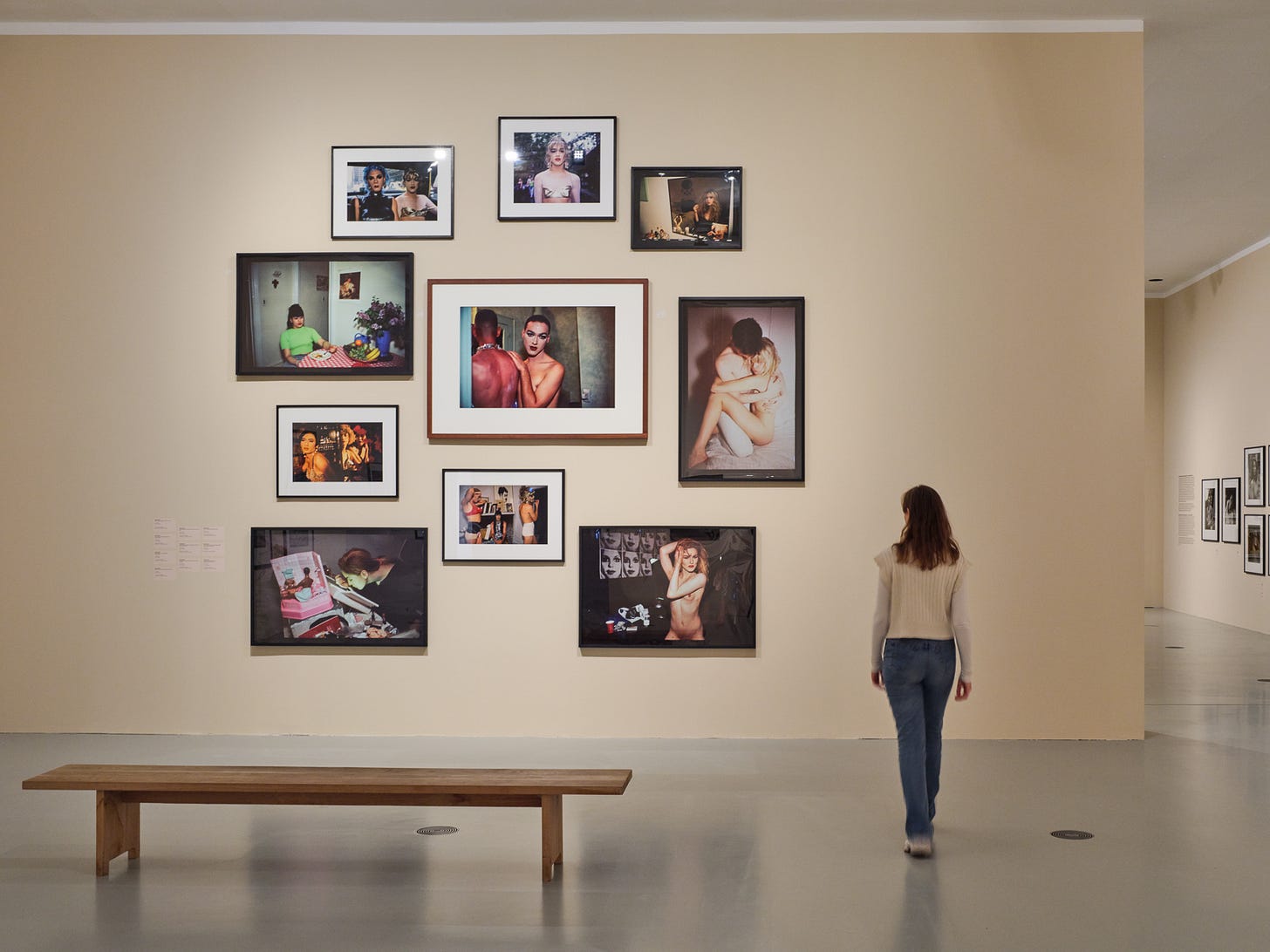
I was touched by how Nan depicted her friend Cookie Mueller through their laughs and tears, through loss and joy, up until her passing. As a friend, as a woman, as a lover, as a mother, as herself. And while Nan portrays her friends and dear ones gently and with care, she is unsparing towards herself. She just got beaten up, and what does she do? She rushes to a mirror to take a picture of her bruised face, like in her 1984 portrait or her pic with Cookie after she got punched in 1986. Does anything even happen in between? Does she even take time to process what somebody did to her? Does she prioritize documentation over compassion for herself?
I was mesmerized by two bathroom self-portraits. As I said in my review of a Sarah Kürten (Millennial, German) show, bathrooms are arguably the only place in your home where you can fully be yourself. A place for your vulnerability, open to your meltdown, your taking off your make up, your throwing up, your facing yourself in the mirror. In Nan’s Self-Portrait in My Blue Bathroom, London (1980), the harsh shadows through the blinds draw lines on her skin. She looks at herself in the mirror, which is confined to the upper left corner of the room.
In her Self-Portrait in My Blue Bathroom, Berlin (1991), her head is similarly confined by the mirror frame and the tiles; only her reflection is present. She doesn’t even look at the mirror; her eyes are directed at something else. In both pictures, she’s taking up a fraction of the space. Both bathrooms are blue, as highlighted by the titles. Color seems important here, a reflection of her emotions, maybe? God, that sounds so cheesy, but I really think that.
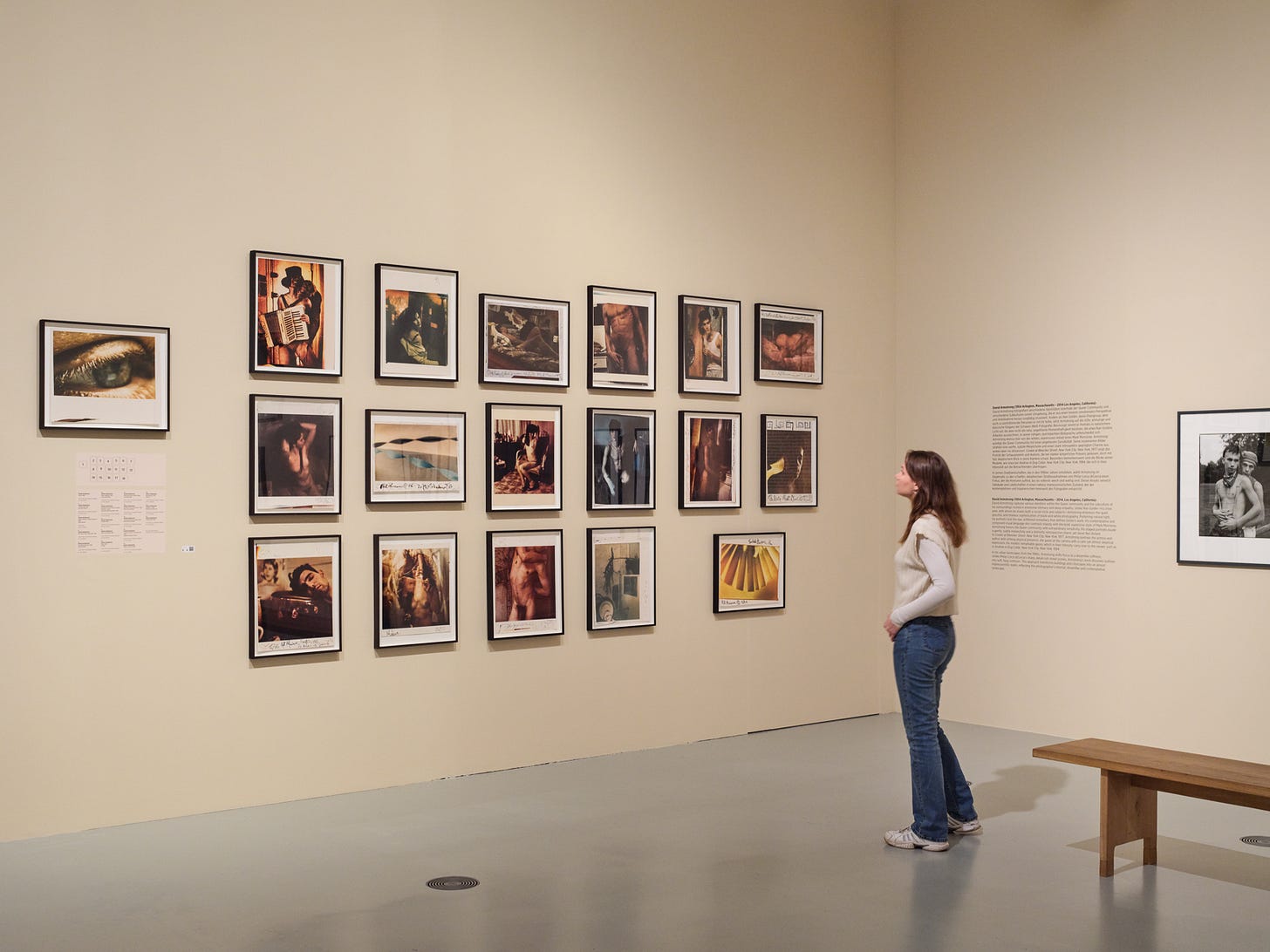
Philip-Lorca kind of falls out of the picture with his staged and stylized photographs. He becomes an outsider among these outsiders. The titles sound like the names of runway collections, which adds to the staged, artificial character. His rather large-scale photographs are imbued with Jeff Wallian (Baby Boomer Canadian) stiffness. My favorite was W, September 2000, #2/2000: In a luxurious hall, a buttnaked (hot) bronze man is showering in a glass cube. Motionless, his face is reflected in the glass. Rich white people sit and stand around. While the men do their best to ignore this elephant in the room, one elderly lady in pearls is distracted by him. Through his legs, I see a younger woman. I don’t know if she broke the fourth wall staring at me or if she’s mesmerized by him. If Philip-Lorca’s work didn’t serve as inspo for Triangle of Sadness (2022)…
Some of his works, though, are more lively, if that’s the right word. Perhaps not… They are warmer, they bring across a sense of the people portrayed being alive, being actual human beings, and not just mannequins like those in the works I mentioned earlier. His photograph Mary and Babe, N.Y. (1982) particularly stood out to me: In a slightly messy interior setting, a woman sits in an armchair with a black dog in her lap. She smokes a cigarette and attentively observes the person in the foreground. They’re ambiguous, their body from the chest upwards is cut from the frame, and it’s unclear whether they’re in the process of undressing or getting dressed again. I got flashbacks to Helmut Newton’s (1920 - 2004, Australian) iconic photograph Woman Examining Man (negative 1975; print about 1984). Helmut’s vision is full of unbearably hot tension. It’s different here. What takes away the sexual tension in Philip-Lorca’s perspective on this couple is the daylight shining through the curtains. And the dog’s awkward side eye.
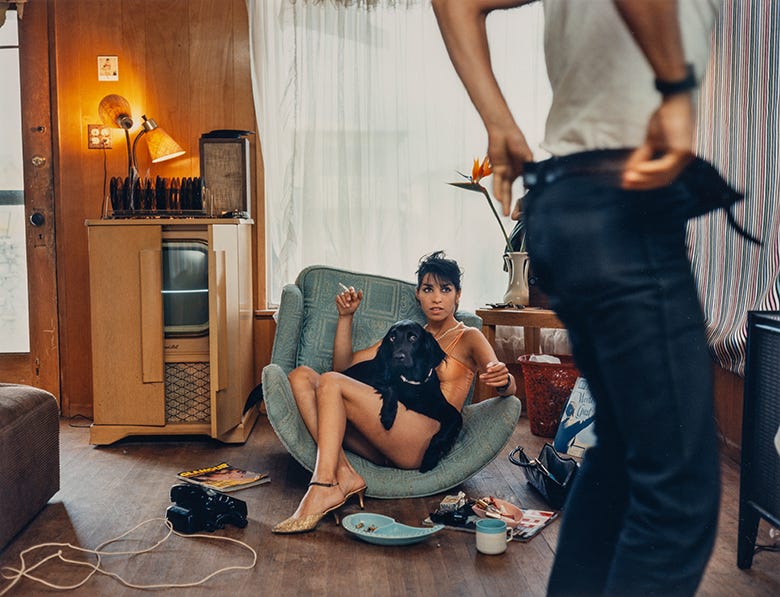
Britta Thie: STUDIO
I remember seeing Britta’s (Millennial, German) work a few years ago at the Leopold-Hösch-Museum as part of the Günther Peill Foundation 2022 scholarships exhibition. For some reason, her works didn’t catch me back then the way they do here in Hamburg. Her show ties back into the Franz Gertsch presentation: Both work hyper-realistically, with an interest in the artificial, the technological gaze on our surroundings. Britta, too, bases her paintings on photographs (and drawings). Her motives are film sets.
Walking into the show even feels like walking into a movie set (or at least I assume that this is what it would feel like): There’s boxes, wooden walls with paper notes stuck to them, cords and cables sticking out of some futuristic polygonic structure. Enough for some worldbuilding and not too much to slip into kitsch amusement park queue area design.
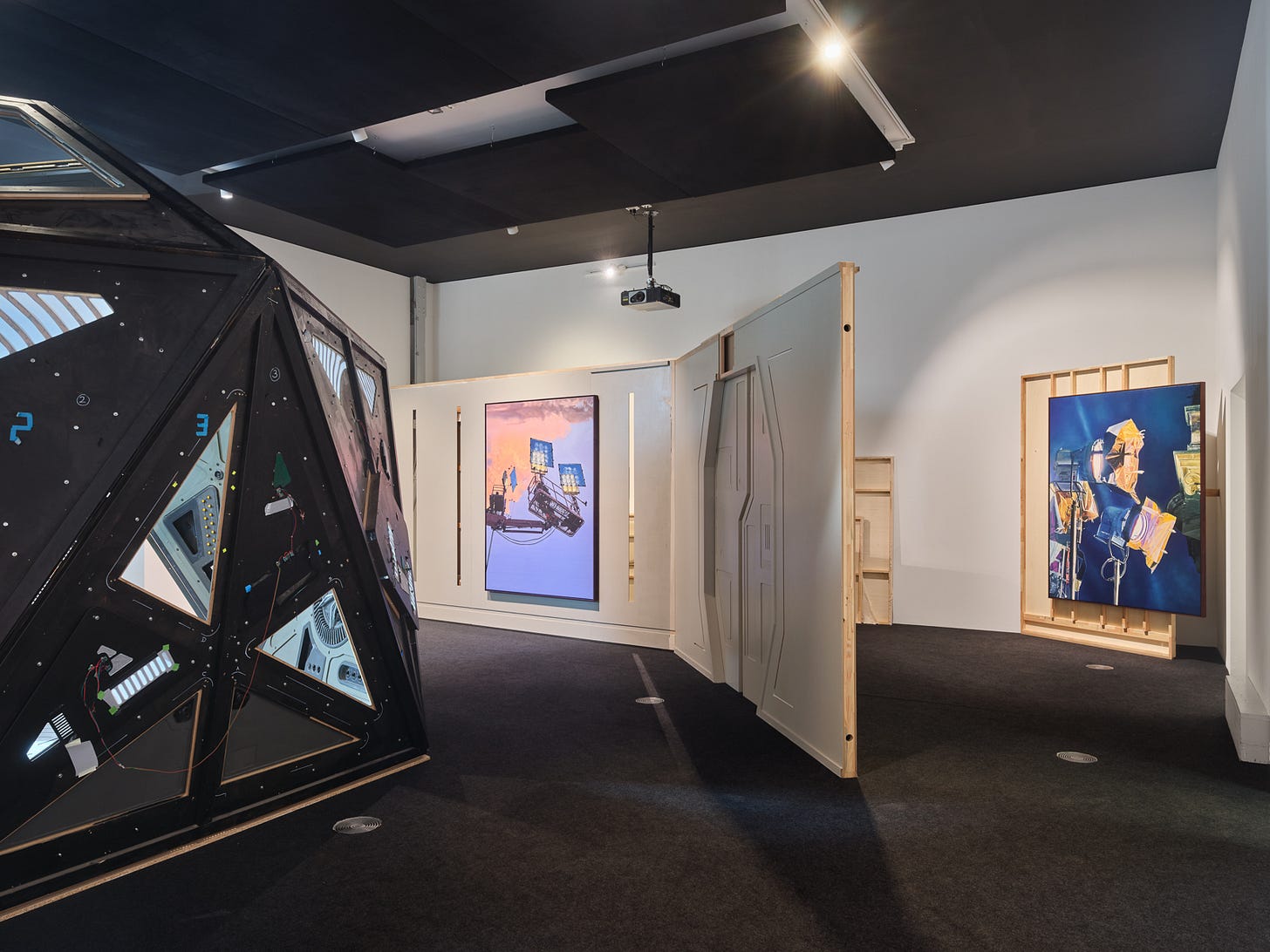
Britta stages the behind-the-scenes. Her paintings feature filming equipment for movie production. She never shows what is in the making but focuses on what’s needed to make the magic happen. And you know what’s odd? Even though Britta depicts expensive high-tech equipment, all those machines, the expensive cameras, the heavy light equipment, the green screens, the buttons, and the cables: All of that already feels dated somehow. Let me explain.
Slider (2024) depicts a camera set in front of a mirror in a baroque palace. Or am I mistaken? How do I know? That could easily be a fake wall. A tiny bit of space is enough to suggest a real place, you can’t tell what’s fake. And just the way that mirror behind the camera was once brand new, shiny, and rust-free (supposed that it’s not artificial scenery), this camera is the newest standard right now (I guess, I’m not a camera operator lol), but it, too, will be useless old tech one day.
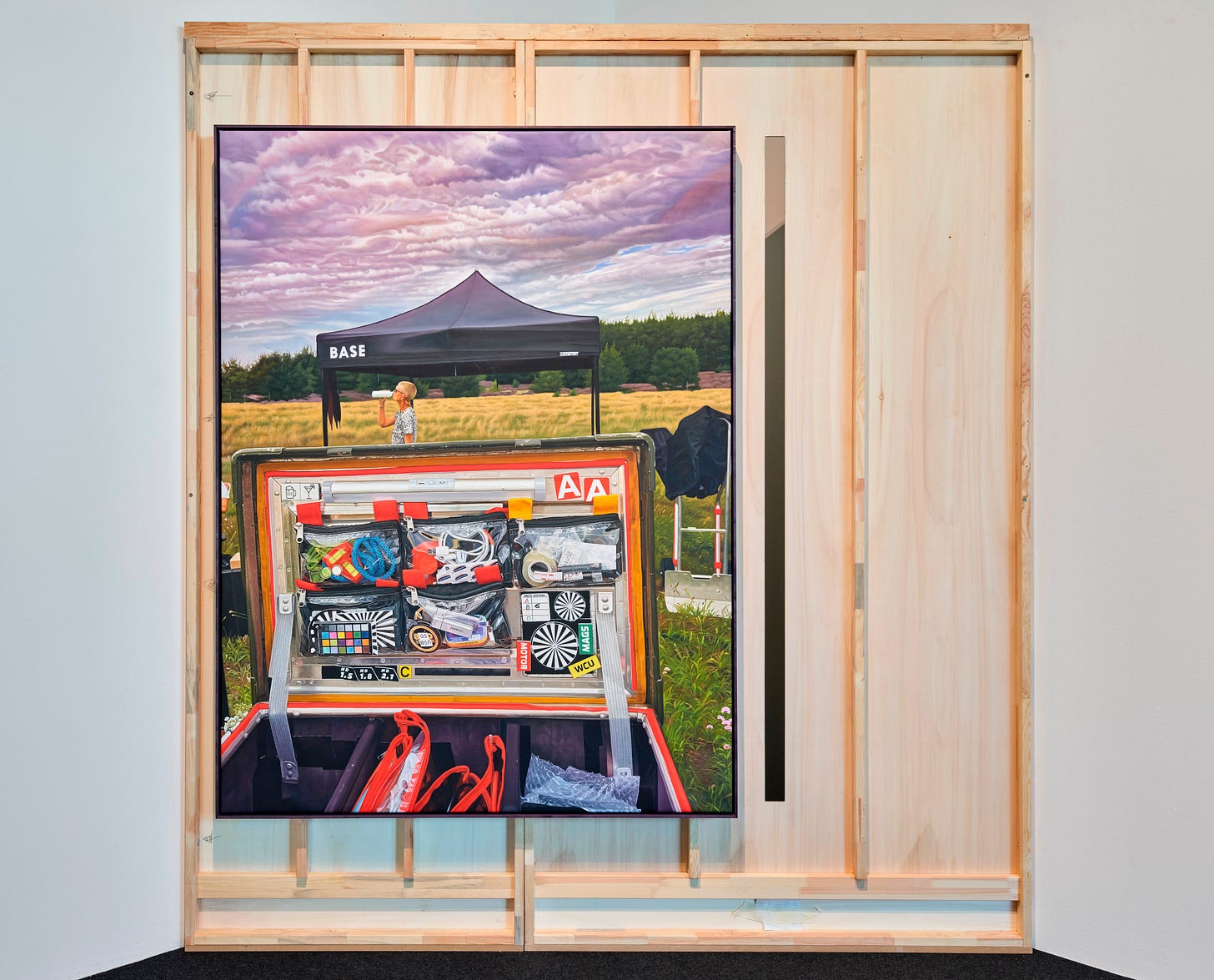
Right next to it, the painting Candlelight (2024) shows a similar wall (perhaps the same building or set?) with light equipment in front of it. That one feels like a technological timeline: A modern lamp, baroque candles next to it, real daylight coming in through the curtain. And in the context of the exhibition, as my bestie remarked, all of that turns fake again, contrasted with the actual light coming through the actual windows in the real physical space we’re in.
All this technology used to create impeccable cinematic illusions will be completely out of date at some point. Looking at the AI clips circulating on Social Media, their potential of entirely taking over the physical film industry looks undeniable. It might take some time, and it won’t be tomorrow, but the process is already underway. Will all those chunky machines handle the standoff with a written prompt?
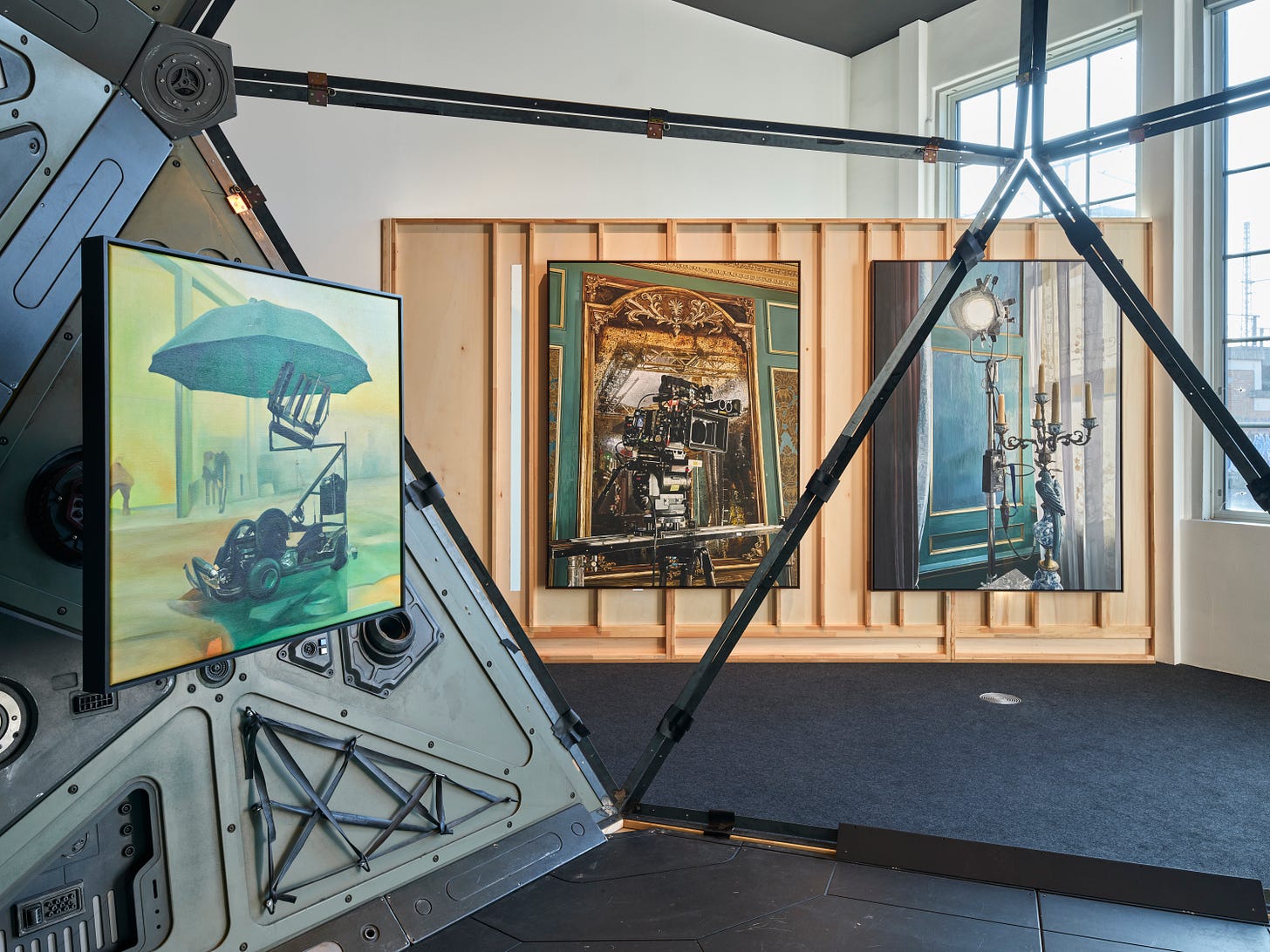
All three shows are on view until May 4, 2025, at Deichtorhallen Hamburg.
Deichtorhallen Hamburg
Deichtorstrasse 1-2
20095 Hamburg
Website
Instagram: @deichtorhallenhamburg
I haven’t seen much art in Venice yet, but I hope to share some with you soon. If you liked this review, make sure to like and share, it helps me a lot.
See you soon!!!
Jennifer
The Gen Z Art Critic




